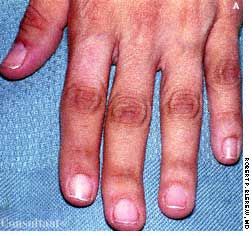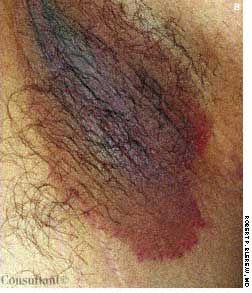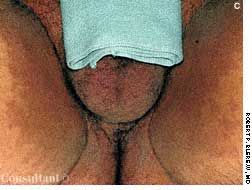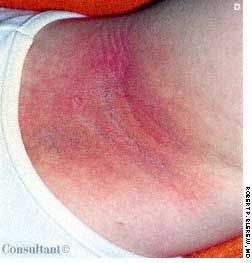- Clinical Technology
- Adult Immunization
- Hepatology
- Pediatric Immunization
- Screening
- Psychiatry
- Allergy
- Women's Health
- Cardiology
- Pediatrics
- Dermatology
- Endocrinology
- Pain Management
- Gastroenterology
- Infectious Disease
- Obesity Medicine
- Rheumatology
- Nephrology
- Neurology
- Pulmonology
Acanthosis Nigricans and Pseudoacanthosis Nigricans in Woman With Parkinson Disease
Acanthosis nigricans is a nonspecific increase of the thickness of the prickle cell layer of the skin and most commonly seen in obese persons.

The dorsal surface of the left hand of a 37-year-old woman with severe Parkinson disease (A) shows finger joint extensor area hyperpigmentation, which is most prominent over the proximal interphalangeal joints. Pigmentary changes can arise in Addison disease, but the patient's normal plasma corticotropin levels ruled out that disorder.
Robert P. Blereau, MD, of Morgan City, La, comments that this patient has acanthosis nigricans, a nonspecific increase of the thickness of the prickle cell layer of the skin. Most commonly seen in obese persons, this condition also affects those with diabetes, corticosteroid excess, pineal tumors, endocrine disorders, and genetic variants; nicotinic acid and estrogen may induce pigmentary changes as well. The hyperpigmentation typically involves the axilla but may arise on flexural areas of the neck and groin, the belt line, dorsum of the finger, around the umbilicus and the areolae of the breast, and in the mouth.

Acanthosis nigricans lesions usually are asymptomatic and do not require treatment. When they occur in nonobese adults, internal malignancies must be ruled out.
Similar hyperpigmentation is seen on the axillae and groin (B and C) of an obese 27-year-old man. The pigmentary changes are asymptomatic and have been present for several years.
The tan pigmentation in the right axilla of a 17-year-old obese girl (D) was bilateral and pruritic. A culture of tissue from the area was negative for Candida. Dr Blereau diagnosed pseudoacanthosis nigricans in these two patients.
Pseudoacanthosis nigricans, or benign acanthosis nigricans, usually is an idiopathic condition associated with obesity. It may be a marker of high insulin levels in obese persons. Heat, friction, and maceration of the flexural fold have been postulated as causes of the hyperpigmentation.

The condition may occur as an autosomal dominant trait without obesity. Pseudoacanthosis nigricans has been induced with nicotinic agents and, rarely, with other agents.
Both of these patients were advised to lose weight. A corticosteroid cream was prescribed for the teenage girl's pruritus.

